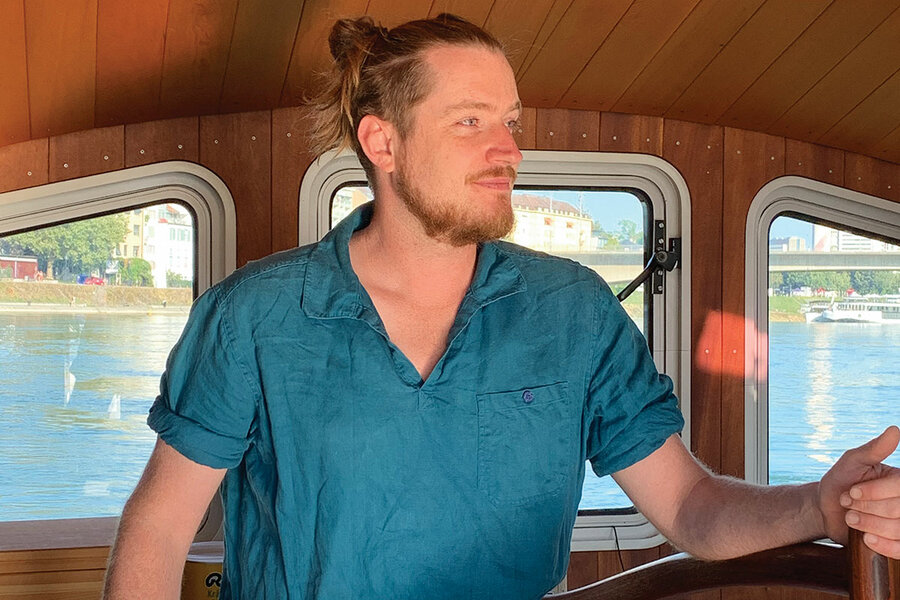For one Swiss family, a life spent on the river
Loading...
| Basel, Switzerland
Pan Thurneysen, tanned, lean, and ponytailed, bends over the side of the vessel he helms, one of the four small current-powered rope ferries that ply the Rhine River in Basel, Switzerland. He’s scooping a bowl of water for a boarding passenger – something he does for all dogs making the crossing with their owners.
Setting it on the wooden deck, he scratches the pooch behind the ears, greeting him in the local Swiss dialect. He then segues effortlessly into another language to engage with his assortment of human commuters, who might be French, English, Italian, American, or Chinese. Mr. Thurneysen also holds a master’s degree in industrial design. But he didn’t make a career of it for long. Instead, he followed his heart and his father’s lead to make his living on the Rhine as a rope ferry helmsman.
“Every day is different,” he says, gazing at the river in one of its quieter moods. “And I enjoy meeting the people who like to cross this way.”
Intrigued by his story, I keep listening.
To say Mr. Thurneysen loves his work is to understate his profound personal and familial ties to the river, widely considered the heart of Basel, the city the Thurneysens have called home for at least 550 years. He, his father, uncle, brother, and two cousins have operated various of the distinctive and anachronistic vessels at different times. Mr. Thurneysen became deeply familiar with their operation as a child accompanying his father, Jacques, on Rhine crossings.
There are many ways to cross the Rhine between Grossbasel (the original town center on the south bank) and Kleinbasel on the north. Both banks are steeped in centuries of history, uniting to form the city of Basel in 1392. Five major bridges span the Rhine here, all busy with bus, clanging tram, pedestrian, and bicycle traffic. But the quiet, five-minute glide on one of the rope ferries operating between bridges casts a special charm on passengers.
Together the vessels carry on a tradition begun in 1854, when the first rope ferry began operating here. Motorless, they rely entirely on the Rhine’s downstream muscle to make the roughly 600-foot crossing.
Mr. Thurneysen has helmed either the Leu or Vogel Gryff since he was 20, after securing the requisite licenses – practical, theoretical (navigational knowledge), and radio communications. “It’s not a requirement,” he adds, grinning, “but it’s a good idea to know how to swim, too.”
Today, his father is operating the Leu upriver, and Mr. Thurneysen suggests that I should spend some time with him.
“He knows the river and its history like no one else,” he tells me. “He’s a Rhine legend ... working barefoot in the summer and wearing long robes and multicolored knit sweaters in the winter. People come from all over just to meet him.”
Since no other passengers are aboard the younger Mr. Thurneysen’s boat on two of our crossings, I eye the schwengel, or vertical polished wood lever that changes the boat’s orientation as it travels from one side to the other. I ask if I can try my hand at it. Mr. Thurneysen nods, and I become a helmswoman for a few heady seconds, marveling as the little vessel leisurely points its nose south from Kleinbasel when I slide the heavy lever left to right.
One of the principal skills in piloting the small boats is avoiding other traffic – from swimmers to enormous barges, some of which barely fit through the stone arches of the picturesque Mittlere Brücke. The barges announce their approach through the city via the ferries’ navigation systems. The swimmers do not, often floating downstream in their own silent worlds.
“It can be a challenge avoiding them,” Mr. Thurneysen acknowledges.
After an hour, I walk upriver to the Leu. Aboard, I talk with Jacques Thurneysen on the open deck. I had ridden before with him, I realized, when the river was high and wild, the rushing current just below deck level.
He piloted the Leu for 30 years before passing its schwengel to his son Noa. The Thurneysen patriarch, now in his 70s, still helms the craft he loves once or twice a week, no longer barefoot. On this day he sports a sleeveless T-shirt reading, “Enjoy the Ride While You’re on It.” He recounts tales of river rescues laconically. He has helped swimmers in peril come aboard at times.
The little Leu offers perhaps the most spectacular view of Basel’s Gothic Münster available from any vantage point. If you disembark, there are long flights of stone stairs to negotiate to reach the cathedral itself, high above the city – or you can opt to ride back.
All of the rope ferries are owned by a private foundation, which leases them to the ferry pilots, or fährimaa. The city’s ferry association offers memberships that help support the enterprise. The fare itself is a bargain for the serene experience the timeless vessels afford: Adults ride for two Swiss francs, children for one.
Owners also pay a franc for a bicycle or dog. But that includes water for the dog, at least on the Vogel Gryff.








